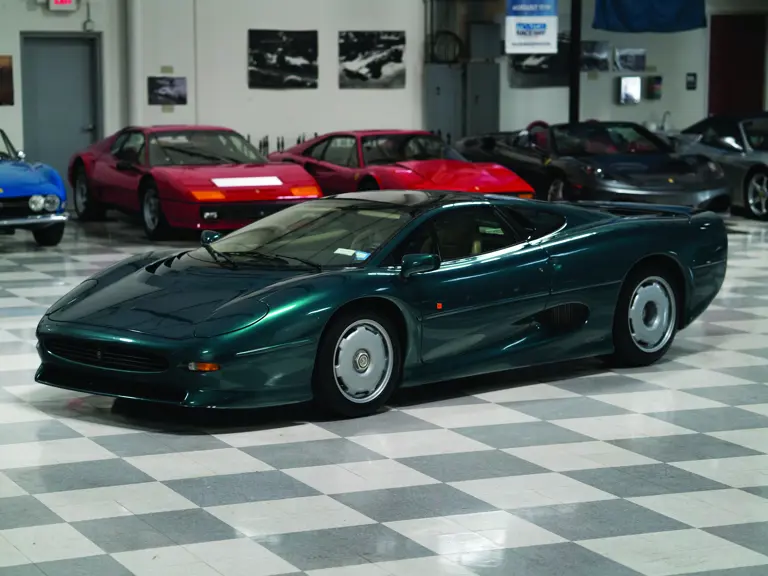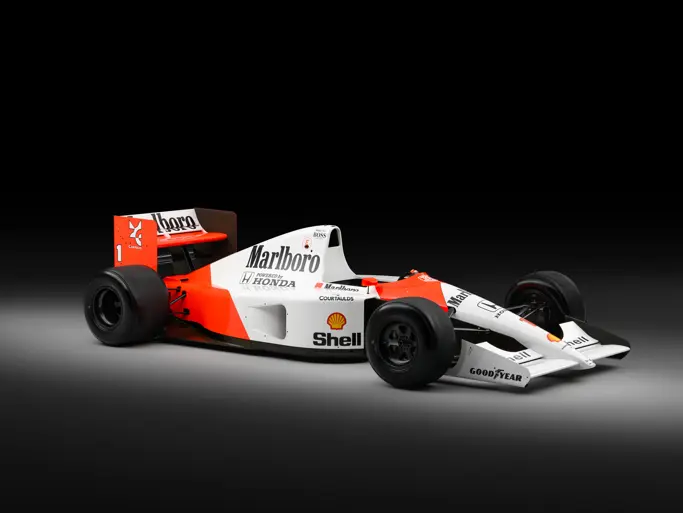
1994 Jaguar XJ220
{{lr.item.text}}
$357,500 USD | Sold
{{bidding.lot.reserveStatusFormatted}}
- Dry sump twin-turbocharged 3.6-liter, 540-hp six-cylinder
- Six-speed manual transmission
- Less than 300 reported built
- Odometer displays less than 8,700 kilometers
- Certain service records
- Exclusive and rare
- Period road tests proclaimed "savage acceleration"
The SS 100, XK 120, XK 140, XK 150, C-Type, D-Type, XK SS and E-Type are all considered as some of the most beautiful and well-respected cars of all time, and notably, all were produced by Jaguar. The company, known for building some of the most achingly beautiful sports cars in the world, seemingly always had another trick up its sleeve when the public thought that it could simply do no better in design interpretation.
In 1992, the XJ 220 was the latest and greatest Jaguar sports car and more than worthy of being mentioned in the same breath as its forefathers. Like its predecessors, it was clothed in svelte and aerodynamic bodywork and its origins were rooted in Jaguar’s rich motorsport heritage. The car was conceived by Jim Randall, the then director of engineering, who was inspired by Jaguar’s sports racers of past. Randall brought a model he built into work and it was decided that it would be made into a full-scale concept. He then recruited a band of volunteers to get to work on the car, as a “quasi-skunk-works project” that would challenge the fastest automobiles on the planet. The group wished to create a modern version of the successful Jaguar 24 Hours of Le Mans racing cars of the 1950s that could be entered into FIA Group B competitions. The XJ 220 made use of engineering work undertaken for Jaguar's then current and very successful racing car family.
The car was developed in conjunction with Tom Walkinshaw Racing. TWR had developed its own engine for their next series of cars; the XJR-10 (for IMSA) and XJR-11 (for WSCC) of 1989 and 1990, the V-6 turbocharged 3.5-liter was capable of far more power than the V-12 but was less suited to 24 hour racing, hence the XJR-12 was deployed at Le Mans and the 24 Hours of Daytona. Even though Jaguar originally intended for the XJ 220 to be powered by a V-12, the dry sump twin-turbocharged 3.6-liter, 540-hp six-cylinder provided more than enough performance, as it could accelerate the car through its six manual gears to a top speed of 212-mph, making it the fastest car in the world at the time of its unveiling. The Jaguar XJ 220 is reported as having held the Nürburgring Nordschliefe production car lap record between 1992 and 2000 with an impressive time of 7:46.36 driven by John Nielsen. Nielsen was teammates with Price Cobb and Martin Brundle when their Silk Cut Walkinshaw Racing Jaguar XJR-12 won Le Mans in 1990.
The initial XJ 220 concept car was unveiled to the public at the 1988 British International Motor Show, held in Birmingham, England. The encouraging reaction prompted Jaguar to put the car into production; some 1,500 deposits of £50,000 each were taken, and deliveries were planned for 1992. In reality, less than 300 would be built during its limited production run.
Press coverage of the concept XJ 220 in 1988 was overwhelmingly positive and contributed to the decision in 1989 to put the XJ 220 into limited production. The production version of the car was first shown to the public in October 1991, at the Tokyo Motor Show. The first car was released for press review in autumn 1991. Respected Autocar reviewer Andrew Frankel was the first journalist to road test the car and reported: "Savage acceleration really is a given here. What's really incredible about the XJ 220 is its ability to provide such performance in a way that never, ever intimidates."
The XJ 220 presented here is strikingly presented in green with tan interior. The tan interior shows minor wear, mainly in the sill areas from entering and exiting the supercar. The odometer displays less than 8,700 kilometers; additional equipment includes four-wheel disc brakes, factory alloy wheels, Willans safety harnesses, leather-covered center console, Alpine sound unit with cassette, owner’s manuals and service records from Muncie Imports and Classics since 2004. Labels are affixed that indicate that show this Jaguar XJ 220 was EPA compliant in terms of its emissions equipment; however the current state of the emissions equipment and its functionability is unknown.
The XJ 220, over 20 years old and still one of the fastest cars on the planet, catapulted Jaguar into the forefront of the supercar world when it was new, and it still demands respect from enthusiasts today. It continues to embody the best of what the marque has come to symbolize: world-beating performance, stunning coachwork, and distinct British character and sophistication. Exclusive and rare are always a good combination; the Jaguar XJ 220 will confirm your own fine tastes in motorcars.


 | Santa Monica, California
| Santa Monica, California


